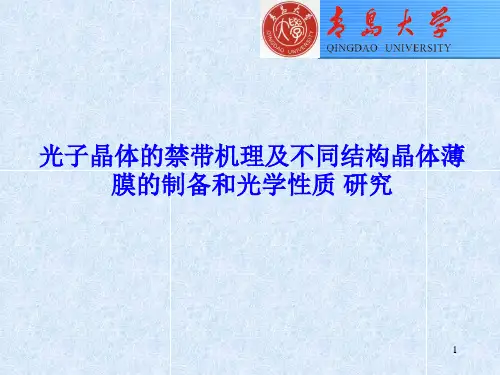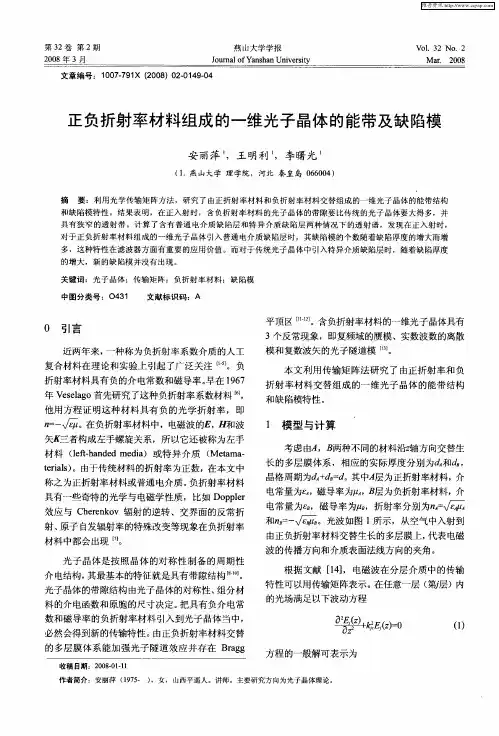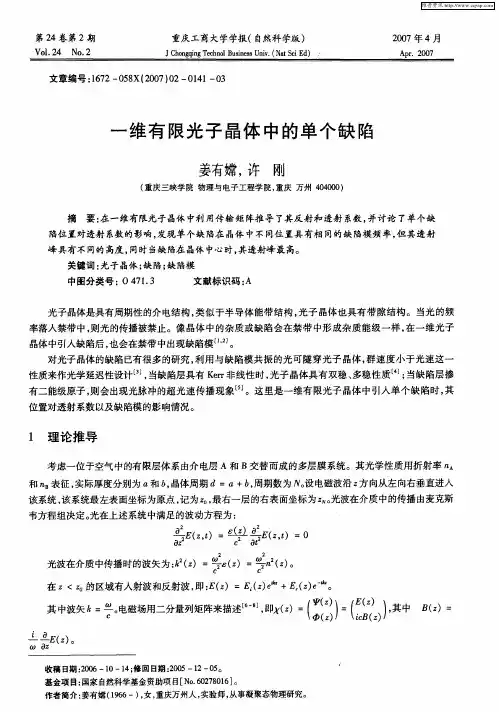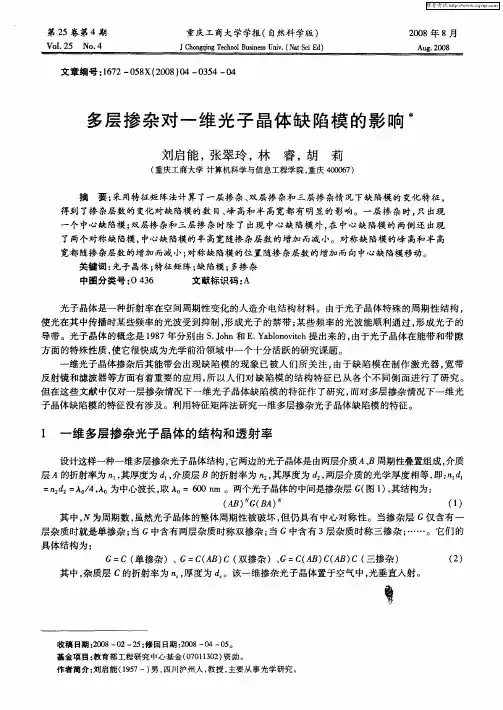含双缺陷光子晶体的缺陷模特性及应用
- 格式:pdf
- 大小:188.15 KB
- 文档页数:3
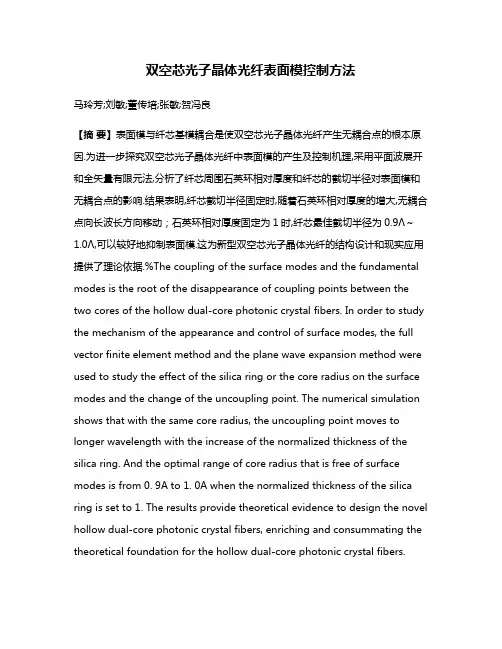
双空芯光子晶体光纤表面模控制方法马玲芳;刘敏;董传培;张敏;贺冯良【摘要】表面模与纤芯基模耦合是使双空芯光子晶体光纤产生无耦合点的根本原因.为进一步探究双空芯光子晶体光纤中表面模的产生及控制机理,采用平面波展开和全矢量有限元法,分析了纤芯周围石英环相对厚度和纤芯的截切半径对表面模和无耦合点的影响.结果表明,纤芯截切半径固定时,随着石英环相对厚度的增大,无耦合点向长波长方向移动;石英环相对厚度固定为1时,纤芯最佳截切半径为0.9Λ~1.0Λ,可以较好地抑制表面模.这为新型双空芯光子晶体光纤的结构设计和现实应用提供了理论依据.%The coupling of the surface modes and the fundamental modes is the root of the disappearance of coupling points between the two cores of the hollow dual-core photonic crystal fibers. In order to study the mechanism of the appearance and control of surface modes, the full vector finite element method and the plane wave expansion method were used to study the effect of the silica ring or the core radius on the surface modes and the change of the uncoupling point. The numerical simulation shows that with the same core radius, the uncoupling point moves to longer wavelength with the increase of the normalized thickness of the silica ring. And the optimal range of core radius that is free of surface modes is from 0. 9A to 1. 0A when the normalized thickness of the silica ring is set to 1. The results provide theoretical evidence to design the novel hollow dual-core photonic crystal fibers, enriching and consummating the theoretical foundation for the hollow dual-core photonic crystal fibers.【期刊名称】《激光技术》【年(卷),期】2011(035)006【总页数】4页(P748-751)【关键词】光纤光学;表面模;全矢量有限元法;石英环相对厚度;纤芯截切半径【作者】马玲芳;刘敏;董传培;张敏;贺冯良【作者单位】重庆大学通信工程学院,重庆400044;重庆大学通信工程学院,重庆400044;重庆大学通信工程学院,重庆400044;重庆大学通信工程学院,重庆400044;重庆大学通信工程学院,重庆400044【正文语种】中文【中图分类】TN253引言光子晶体光纤是通过在无限的光子晶体内引入缺陷纤芯而形成的。
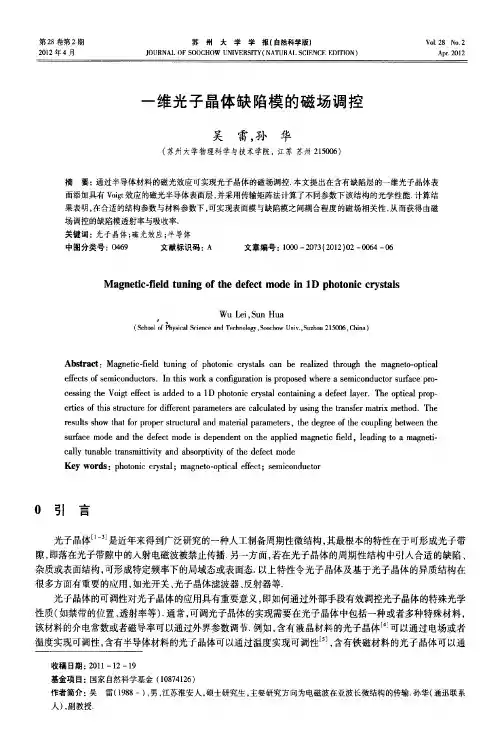
第28卷第2期2012年4月苏州大学学报(自然科学版IJ O U R N A L0F SO O C H O W U N I V E R SI T Y(N A T U R A L SC IE N C E E D TT T O N)V01.28N o.2A pr2012一维光子晶体缺陷模的磁场调控吴雷,孙华(苏州大学物理科学与技术学院,江苏苏州215006)摘要:通过半导体材料的磁光效应可实现光子晶体的磁场调控.本文提出在含有缺陷层的一维光子晶体表面添加具有V oi昏效应的磁光半导体表面层,并采用传输矩阵法计算了不同参数下该结构的光学性能.计算结果表明,在合适的结构参数与材料参数下,可实现表面模与缺陷模之问耦合程度的磁场相关性,从而获得由磁场调控的缺陷模透射率与吸收率.关键词:光子晶体;磁光效应;半导体中图分类号:0469文献标识码:A文章编号:1000一2073(2012)02—0064一06M agnet i c-nel d t ul l i n g of t he de f ec t m ode i n1D phot oIl i c cr yst a l sW u Lei.Sun H ua,(s ch00l0f Ph ysi cal鼬i ence and T echn010舒,s00c how unj v.,s uzh叫215006,chi na)A bs t r act:M ag net i c—f i el d t uni ng of ph ot oni c cr yst al s c an bere al i ze d t hr ough t he m agnet o-op t i cal ef玷ct s of s em i c onduct or s.I n t hi s w or k a c onfi gura t i on i s pr opo s ed w her e a s em i con duct or s udhce pm—c es si ng t he V oi gt ef玷ct i s added t o a1D phot oni c cr yst a l c ont a i ni ng a def bct l ayer.The叩t i cal pr op—er t i es of t hi s s t m ct ure f or di H-er ent param et er s ar e c al cul at ed by usi ng t he t r ans f e r m at r i x m et hod.T her es u hs sh ow t h at f or pr op er st nl ct ur a l and m a t eri a l param et er s,t he deg r ee of t he coupl i ng bet w een t hes uI fa ce m ode and山e de f bct m ode is dependent on tl l e appl i ed m agnet i c f i el d,l e adi ng t o a m a gne t i—cal l y t unabl e t m nsm i t t i vi t y and absor pt i V i t y of t he de f ect m odeK ey w or ds:p hot oni c c rys t a l;m agnet o-opt i c al eH.ect;s em i conduct orO引言光子晶体¨。
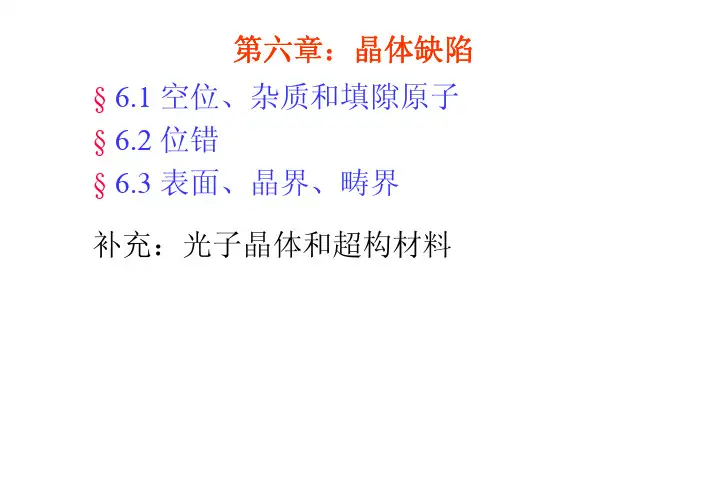
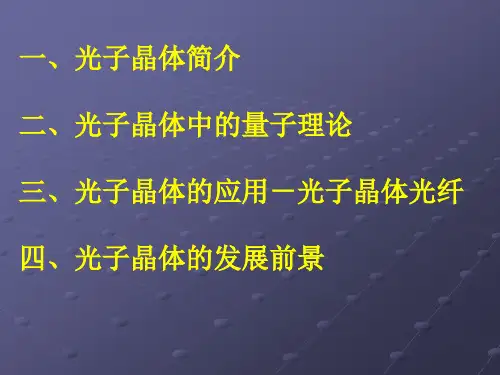
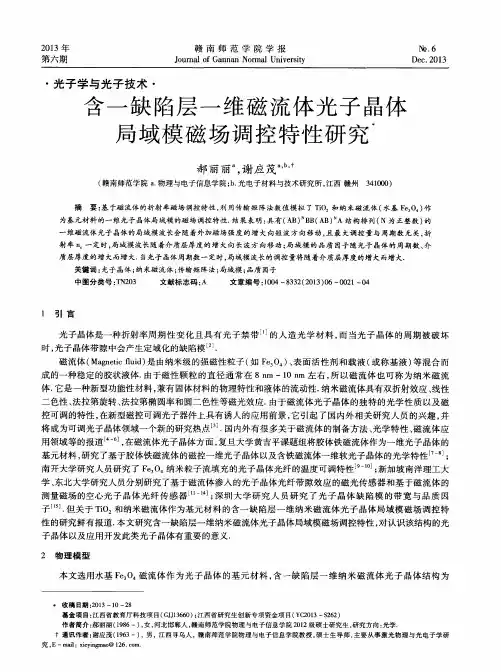
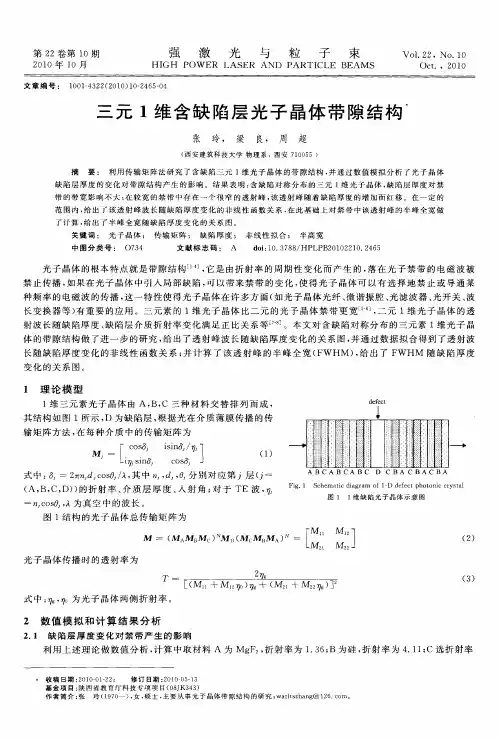
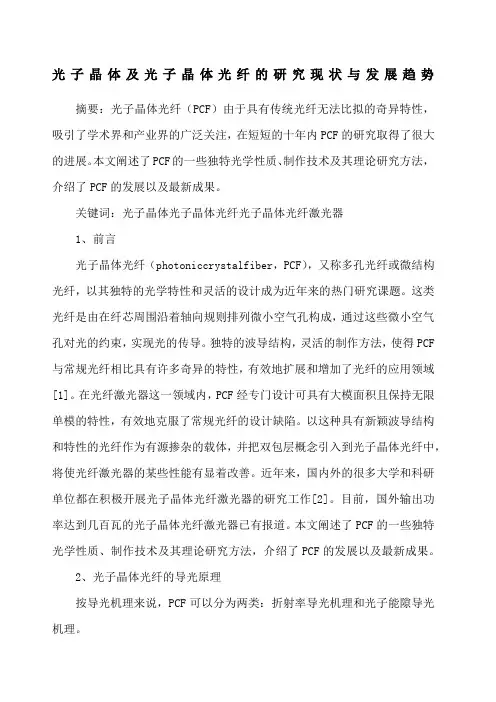
光子晶体及光子晶体光纤的研究现状与发展趋势摘要:光子晶体光纤(PCF)由于具有传统光纤无法比拟的奇异特性,吸引了学术界和产业界的广泛关注,在短短的十年内PCF的研究取得了很大的进展。
本文阐述了PCF的一些独特光学性质、制作技术及其理论研究方法,介绍了PCF的发展以及最新成果。
关键词:光子晶体光子晶体光纤光子晶体光纤激光器1、前言光子晶体光纤(photoniccrystalfiber,PCF),又称多孔光纤或微结构光纤,以其独特的光学特性和灵活的设计成为近年来的热门研究课题。
这类光纤是由在纤芯周围沿着轴向规则排列微小空气孔构成,通过这些微小空气孔对光的约束,实现光的传导。
独特的波导结构,灵活的制作方法,使得PCF 与常规光纤相比具有许多奇异的特性,有效地扩展和增加了光纤的应用领域[1]。
在光纤激光器这一领域内,PCF经专门设计可具有大模面积且保持无限单模的特性,有效地克服了常规光纤的设计缺陷。
以这种具有新颖波导结构和特性的光纤作为有源掺杂的载体,并把双包层概念引入到光子晶体光纤中,将使光纤激光器的某些性能有显着改善。
近年来,国内外的很多大学和科研单位都在积极开展光子晶体光纤激光器的研究工作[2]。
目前,国外输出功率达到几百瓦的光子晶体光纤激光器已有报道。
本文阐述了PCF的一些独特光学性质、制作技术及其理论研究方法,介绍了PCF的发展以及最新成果。
2、光子晶体光纤的导光原理按导光机理来说,PCF可以分为两类:折射率导光机理和光子能隙导光机理。
2.1折射率导光机理周期性缺陷的纤芯折射率(石英玻璃)和周期性包层折射率(空气)之间有一定差别,从而使光能够在纤芯中传播,这种结构的PCF导光机理依然是全内反射,但与常规G.652光纤有所不同,由于包层包含空气,所以这种机理称为改进的全内反射,这是因为空芯PCF中的小孔尺寸比传导光的波长还小的缘故[3]。
2.2光子能隙导光机理理论上求解光波在光子晶体中的本征方程即可导出实芯和空芯PCF的传导条件,即光子能隙导光理论。
